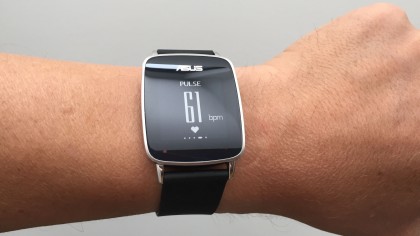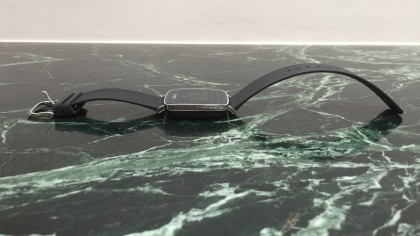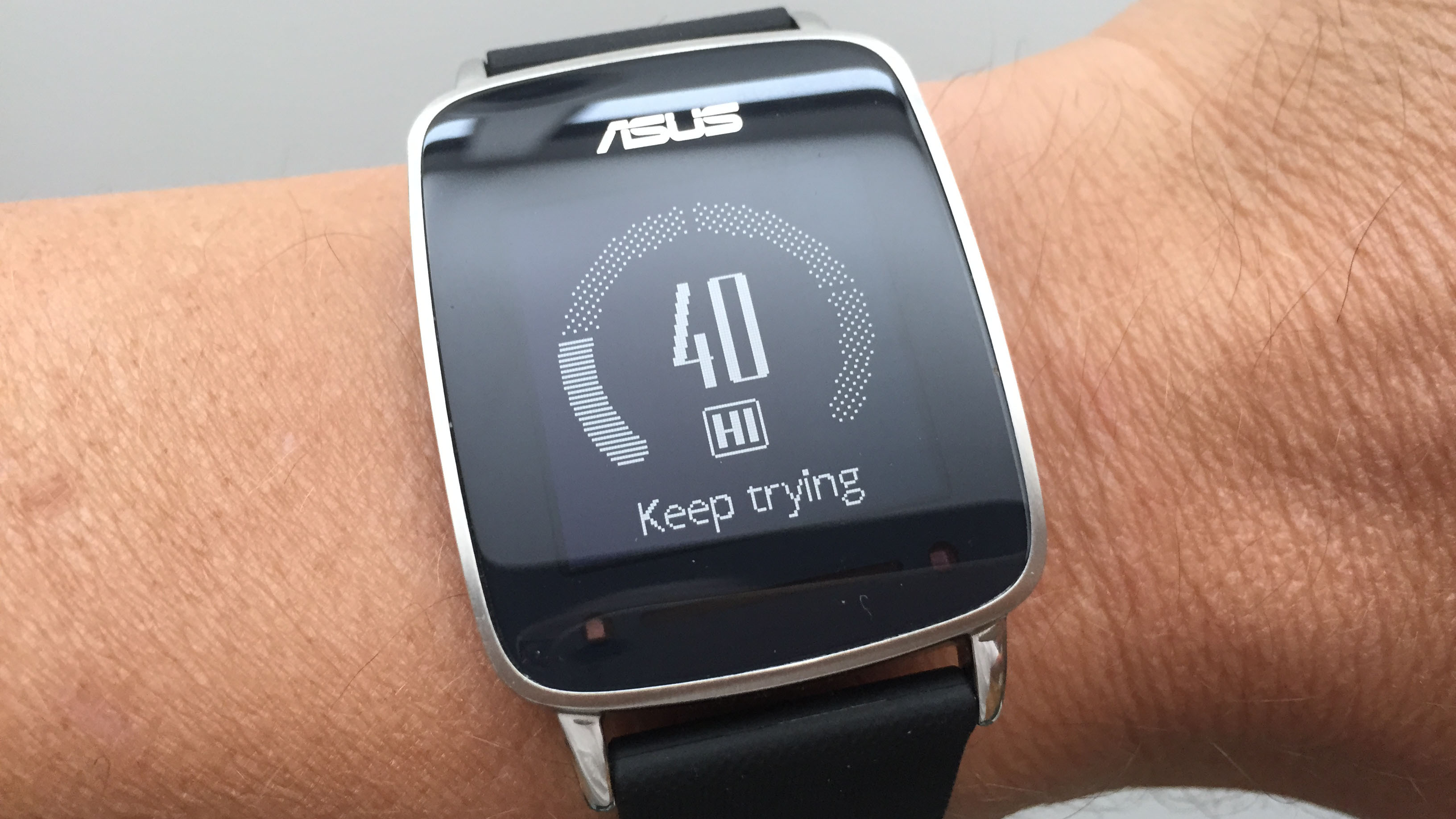Why you can trust TechRadar
Other elements are more successful. The optical heart rate monitor is accurate enough for low-level activity and wellness monitoring, though not for runners who want to get into zone training or anything like that. The Asus VivoWatch checks your pulse periodically. Worn alongside an Apple Watch to test the readings, the two devices were within one beat per minute of each other.
When you're exercising, the watch steps up its reading frequency to continuous. This exercise mode can be activated by holding down the side button. The watch displays time elapsed with the BPM below.

If that's not enough detail, exercise mode has four other displays you can swipe between: calories burned, steps taken, heart rate since you started exercising, and distance and speed stats. All the screens are highly readable.
More data is available when you're not running, which is the only exercise it really counts. As with rival monitors, it counts your steps and calculates calories burnt from this. The totals were pretty similar to those on a Jawbone UP3 worn at the same time.
Overall, the VivoWatch seemed as accurate in its measurements as its main market rivals. Which is to say "Not totally, but hey, it's good enough to get an overview."

The watch shows your total exercise for the day and how much of that was aerobic exercise. There's also a UV sensor which measures the sunlight and tells you if you're in baking sun or grey daylight. It doesn't tell you to get out of the sun if you're being over-exposed, so again, that's of limited use.
App
The HiVivo app has a clean design, but is quite basic. For instance, the sleep monitoring information is a lot less detailed than on a rival gadget like the Jawbone UP3. Analysis is limited, too.
Sign up for breaking news, reviews, opinion, top tech deals, and more.
More context and insight about the data would have been useful and arguably more valuable than a happiness quotient.
Since there's no GPS in the watch, unlike the Sony Smart Watch 3, distance data is based on your height and weight details entered into the app.
Notifications, sleep monitoring and other features
Although this looks like a smartwatch, in a certain light, it's really not. Notifications are limited to being told you've received a call, nothing more. The watch's alarm function can wake you up after counting your sleep.
You can set the watch to give you a nudge when you've been sitting too long and there are also lights that come on when you're exercising to congratulate you on being in the "correct" heart rate zone. If you work too hard and your heart rate is "too high", it turns red, however.
Like many fitness monitors, the Asus Vivowatch calculates sleep. Unlike some, it does so without having to tell it when you're nodding off. The information it captures includes how much sleep you had, how many times you turned over, and what your "comfort percentage" is.
The app says that good sleep is between 30 and 40 per cent on the comfort scale. I scored 36% and immediately felt better knowing this was in the comfort range, so maybe there is something in this Happiness Index after all.
We like
The Asus VivoWatch has several things in its favour. The screen is large and easy to read, the battery life is class-leading for a fitness tracker with a screen, and you can't accuse it of trying to do too much.
It's also on the cheap side for a tracker that's both waterproof and has heart rate monitoring built on.
We dislike
The useful fitness tracking is limited to walking - it has a stab at tracking your runs but without GPS it doesn't make an amazing job of it. There are lighter sporty-smart watches on the market, too.

The design won't be to everyone's taste, either of the watch or its strap, and the app leaves a certain amount to be desired as well. I'm also not at all convinced by the 'Happiness Index', but maybe that's just me being grumpy.
Verdict
Where the Asus VivoWatch shines is in its battery life and having a clear watch face that's always on and easily read in any light. The heart rate monitor lets you track your resting heart rate and has some use for running and other exercise, although the app doesn't really want to track anything other than walking and sleep.
Overall, this is a fun fitness watch with a curious 'wellness' addition in the form of the Happiness Index. It's well priced and capable, but it's less impressive as a lifestyle fitness tracker than the Jawbone UP3, more expensive than the much neater looking Garmin Vivosmart, and can't be remotely compared to a "proper" exercise watch such as the Fitbit Surge or a Garmin Forerunner.
It's a reflection of how over-stuffed this sector now is that, while the VivoWatch might have got 3.5 to 4 stars a year or so ago, it's now only recommendable if you must have a big screen and heart rate monitor but don't want to track anything more tiring than walking and sleeping. That seems like a fairly small niche.
- 1
- 2
Current page: Fitness monitoring, app, functionality and verdict
Prev Page Screen, battery, comfort and happiness monitoring